Abandoned homes near wind turbines discovered to be saturated with infrasound (Wisconsin)
Jan 3, 2013
—Calvin Luther Martin, PhD

That quotation is taken from the “Shirley, Wisconsin, ILFN Wind Turbine Report,” which came out a few weeks ago, just before Christmas, (It has a longer, more formal name, but this is the name it’s going by as it ricochets around the Internet.)
The report was commissioned and paid for by the Wisconsin Public Service Commission (PSC). The PSC requested the report because, in the course of taking testimony for the so-called Highland Wind Farm in the towns of Forest and Cylon (St. Croix County, Wisconsin), WTS victims from the existing Duke Energy “Shirley (Wis.) Wind Farm” presented testimony declaring they had to abandon their homes due to ILFN from nearby wind turbines. (In case you don’t know, “ILFN” is shorthand for “infrasound and low frequency noise.”)
“Yikes!” responded the PSC. “We’d better check out these jaw-dropping Shirley claims before allowing Highland Wind Farm, LLC, to build another one of these wind farms!” (The words are mine, not the PSC’s.)
Are you with me, so far? (I know, it’s a little confusing.)
So, the PSC commissioned two agencies to arrange for proper, (hopefully) unbiased turbine noise measurements at selected homes within the Shirley Wind Farm. They chose Clean Wisconsin, a statewide outfit well-known for being vigorously pro-wind turbine (virtually in people’s backyards), and Forest Voice, Inc., which opposes the proposed Highland Wind Farm (because its turbines will be virtually in people’s backyards). Hence, between them, Clean Wisconsin and Forest Voice selected the acousticians. The following is taken from the report.
Four acoustical consulting firms would cooperate and jointly conduct and/or observe the survey. Channel Islands Acoustics (ChIA) has derived modest income while Hessler Associates has derived significant income from wind turbine development projects. Rand Acoustics is almost exclusively retained by opponents of wind projects. Schomer & Associates have worked about equally for both proponents and opponents of wind turbine projects. However, all of the firms are pro-wind if proper siting limits for noise are considered in the project design.
And this is what the four concluded:
The four investigating firms are of the opinion that enough evidence and hypotheses have been given herein to classify LFN [low frequency noise] and infrasound as a serious issue, possibly affecting the future of the industry. It should be addressed beyond the present practice of showing that wind turbine levels are magnitudes below the threshold of hearing at low frequencies.
However, you need to read the entire report; it’s highly instructive and, for people around the world suffering Wind Turbine Syndrome (WTS) from absurdly and criminally-situated wind turbines—it’s a positively religious experience. Hallelujah!
Robert Rand’s submission is especially enlightening regarding turbine noise/vibration as it relates to Pierpont and others’ understanding of Wind Turbine Syndrome.

(Note that Rand gets WTS each time he measures turbine ILFN. God bless him for subjecting himself to this, once again, in the line of professional duty! Bear in mind that, as Pierpont points out in her book, “Wind Turbine Syndrome,” WTS effects are cumulative. In short, Mr. Rand is damaging himself in the interest of science and humaneness—he doesn’t need the money. The man’s a hero!)
The plot thickens. It turns out Clean Wisconsin “redacted” (fancy word for “purged,” “removed”) some vital text from the report before submitting it to the PSC. This is explained in Attorney Anne Bensky’s subsequent submission to the PSC. (Open the report and scroll to the end. Bensky’s submission to the PSC immediately follows the report.) I have appended the section which Clean Wisconsin thoughtfully struck out—without telling the PSC. (You can’t make up this stuff!)
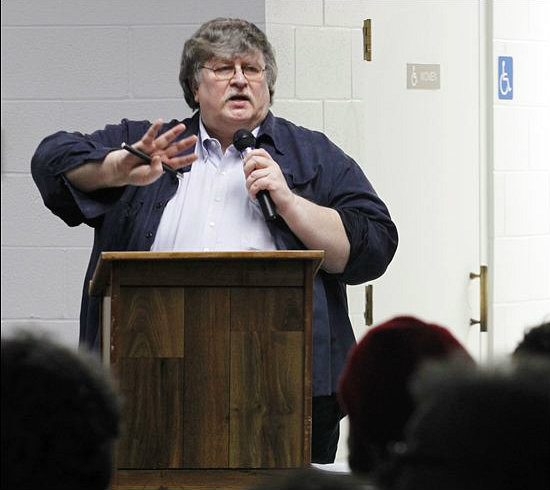
One other thing. Before reading the report, I recommend reading Rick James’s analysis, reprinted here with his permission. James is a seasoned acoustician who has been pioneering the proper and accurate measurement of wind turbine infrasound and low frequency noise.
Please find attached a report for a wind utility in Wisconsin that was the focus of a study requested by, and partly sponsored by, the Wisconsin PSC. The purpose was to determine whether infrasound was present in the homes of three families in the footprint of the Shirley Wind project (owned by Duke Energy). These families have reported adverse health effects since the wind turbine utility commenced operation. All three have been forced out of their homes. They report experiencing symptoms of the type associated with wind turbine syndrome. These families offered to act as intervenor’s in another Wisconsin case, Highland Wind, which is in the application hearing phase. Affidavits were filed representing 50 residents near the utility, describing adverse health effects and home abandonment for the eight-turbine Shirley Wind project (click here for video) using Nordex N100 2.5 MW wind turbines.
Three homes were studied. R1 is about 3500 feet from the nearest wind turbine. R2 is about 1100 feet, and R3 is about 7000 feet away. All three homes were found to have measurable infra and low frequency sound from the wind turbines, with levels decreasing as distance increases. The peak acoustic energy was found at the wind turbines’ blade passage frequency, which is less than 1 Hz for the Shirley Wind turbines.
Most modern, upwind, industrial-scale wind turbines, including the 1.5 MW turbines commonly installed over the past 5 years, can operate with hub rotation speeds that are similar to those of the Nordex. As turbine sizes (blade length, tower height, and in general power output) increase, the more likely it is that the hub rpm will be in the range similar to that of the Nordex units.
Rob Rand has a chart in the Team Report that shows the range of rpm’s against the frequency associated with inducing nausea that shows this trend. This is an important chart for showing how the conclusions for this PSC study of a single wind utility has implications for other wind utilities using other makes and models of wind turbines.
A revision to that chart did not make it into the report as posted on the PSC site, so I have included it, below.
Initially the PSC was going to have the study conducted by George and David Hessler. This posed a problem for credibility with the intervenors and others who know their position from other projects. The attorneys for the citizens’ group, Anne Bensky and Peter McKeever for Forest Voice, and Glenn Reynolds, the attorney for the Town of Forest which also opposes the project, wanted the tests to be conducted but were concerned that the Hesslers would produce a biased study. It was decided they would push for a study that included four acoustics experts, some on the wind industry side (Hesslers), independents (Schomer and Walker), and one who has demonstrated the ability to find infrasound inside homes (Rob Rand).
The purpose of the study was to collect high quality audio samples during periods when the family members were present and “feeling” the wind turbines (emphasis added). Wind speed and direction data at the outdoor microphones and from the wind turbine hub-level anemometer were also collected. Wind turbine power production was also collected. (The data from wind turbines is under a protective order and only available to select reviewers.) The Team Report summarizes the data and protocol. It also includes a Team conclusion and separate appendices from each acoustician, providing additional information about what they observed or derived from the study. They can also file follow-up reports as can other qualified experts within the time frame for responses to the PSC.
Mr. Walker’s equipment was the best of any of the acousticians, and became the focus for data collection. Unlike the instruments traditionally used by acousticians studying wind turbine infrasound, Mr. Walker’s equipment could accurately measure sounds in the lower region of infrasound. It allowed synchronized sampling and recording at multiple sites inside and outside a home over the frequency range from 0.5 Hz to 100Hz. These audio samples have been made available to Wade Bray and me for analysis using Head Acoustics’ software in a similar manner to what was done for the Bray/James study and Noise-Con 2011 paper on the GE 1.5 MW turbine in Ubly, MI.
Although there are details in the report that I would take issue with, I can say that the Team portion of the report presents a major step forward in the discussion about why adverse health effects are being reported by people living near modern, industrial-scale, upwind wind turbines. The primary conclusion of the Team is:
“The four investigating firms are of the opinion that enough evidence and hypotheses have been given herein to classify LFN [low frequency noise] and infrasound as a serious issue, possibly affecting the future of the industry. It should be addressed beyond the present practice of showing that wind turbine levels are magnitudes below the threshold of hearing at low frequencies.”
The argument about whether wind turbines produce infra and low frequency sound and, if they do, is it sufficient to cause adverse health effects, has taken a big step forward with this conclusion. That infra and low frequency sound is a primary characteristic of wind turbine acoustic emissions was established by the Team. The argument that infrasound produced by modern, upwind, wind turbines does not have sufficient amplitude to reach the threshold of hearing (set for steady, pure tones, not the complex mix of tones emitted by wind turbines) raised by the wind industry through its experts like Dr. Leventhall and the many acousticians and others who parrot his opinion, is now discredited.
I think this is a major step forward. We still need to establish what levels and other characteristics of infra and low frequency sound are needed to produce adverse health effects, but the argument that it is not present is shown to be false.
The wind industry and its supporters can no longer say that wind turbines do not produce significant levels of infra and low frequency sound just because the sound pressure levels do not rise to the Threshold of Perception of audible sounds.
Thus, “What you can’t hear, can hurt you” is the surviving paradigm.
Richard James, INCE
“What you can’t hear, can hurt you” is the surviving paradigm.
Except in this man’s mind.
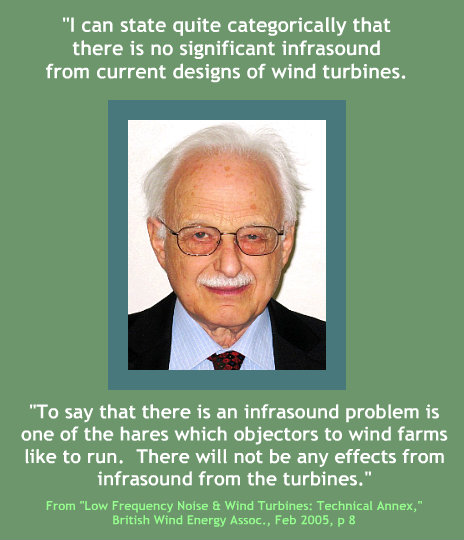
Geoff Leventhall, PhD (Physics)
“Geoff Leventhall,” begins an online puff likely written by himself, “is a consultant, formerly an academic, who works internationally. His main research and consultancy interests have been in problems of low frequency noise and in active attention of noise.
Whilst at the University of London he developed a highly regarded research group in acoustics, personally supervising more than 30 PhD students and a much larger number of MSc students. He left London University as Reader in Acoustics to join W S Atkins, a large UK engineering consultancy, as Head of Acoustics. In 1982 he established the Journal of Low Frequency Noise and Vibration and was editor for the first 18 years. In 1988 he was invited back to an academic post as Professor and Head of the Institute of Environmental Engineering in London, where he stayed for about 5 years. Since then he has been practising as a sole consultant, but continues to examine doctoral theses in acoustics. He is well known in the world of UK acoustics and has been President of his professional body (Institute of Acoustics). He is an Honorary Fellow of the Institute. He is, by invitation, a ‘Distinguished International Member’ of the US Institute of Noise Control Engineering.”
All this may be true. These days, however, he is regarded by many as an enigma, even to fellow scientists who worked with him over the years.
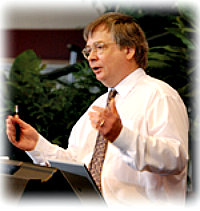
Malcolm Swinbanks, PhD, used to work with Dr. Leventhall
One would think Leventhall would be a “natural,” even the standard-bearer, rallying to the overwhelming evidence that wind turbines generate infrasound which triggers a cascade of pathology now globally referred to as Wind Turbine Syndrome (WTS).
In this you would be mistaken. Leventhall’s opinion of WTS is one of denial bordering on contempt.
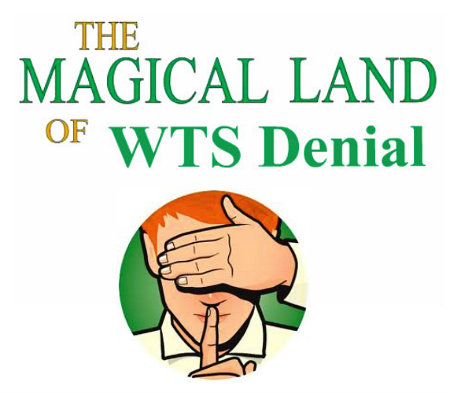
Wind Turbine Syndrome, in his estimation, is basically a hysteria epidemic concocted by Dr. Amanda Harry (the UK physician who, a decade ago, blew the whistle on wind turbines causing ill health), Dr. Nina Pierpont (the American physician who elaborated on Harry’s research, giving its cluster of pathologies the name “Wind Turbine Syndrome”), and Dr. Sarah Laurie (the Australian physician who has further elaborated on Harry and Pierpont, and is now the most prominent physician, globally, battling for government recognition of WTS).
I first realised there might be a problem associated with wind turbines when I was introduced to a couple living near a wind farm in Cornwall. The distance from their home to the nearest turbine is about 400 meters. They told me about poor sleep, headaches stress and anxiety symptoms brought on when the wind was blowing in certain directions. At times, they told me that they have been so disturbed by the noise that after several disturbed nights sleep, they have sought refuge in a nearby bed and breakfast establishment (far enough away not to be similarly affected by the noise).
Since that meeting I have spoken to and/or corresponded with 39 people living between 300meters and 2 km from the nearest turbine of a wind farm all of whom were suffering from the consequences of the noise coming from the turbines. This disturbance is by no means always there and is worse in certain wind directions.
The cases mentioned below are from several wind farms in the UK with a variety of turbine sizes from the smaller, older turbines to the taller more modern turbines. However I have had correspondence from people living near wind farms in New Zealand and Australia and have evidence from other sources, (newspapers, journals and papers) of people being similarly affected in France, Germany, Netherlands and the USA.
What this shows is that there is number of people suffering from the consequences of noise from the wind turbines. I’m sure that the cases mentioned here are probably the “tip of the iceberg” and further independent investigation is warranted. The cases are kept anonymous in order to protect the individuals concerned. There is much concern within communities that if one is seen to complain about the noise that if they decide to move away their properties will be difficult to sell and possibly devalued as a result. Therefore they feel that they are in a “Catch 22” situation.
—Amanda Harry, MD (2007, although she did her first study 3 or 4 years earlier)
There are many things one can say about Geoff Leventhall’s cottage industry of trashing Wind Turbine Syndrome. Perhaps the most salient is that he is not, by any stretch of the imagination or in any capacity whatsoever, a clinician or physician. He’s a PhD in physics. That’s it, folks! He’s no more qualified to comment on clinical medicine than a used car salesman.
Except, this does not deter him. In this he hoists himself, in the manner of Cervantes’s hapless hero, in ever more spectacular ways.
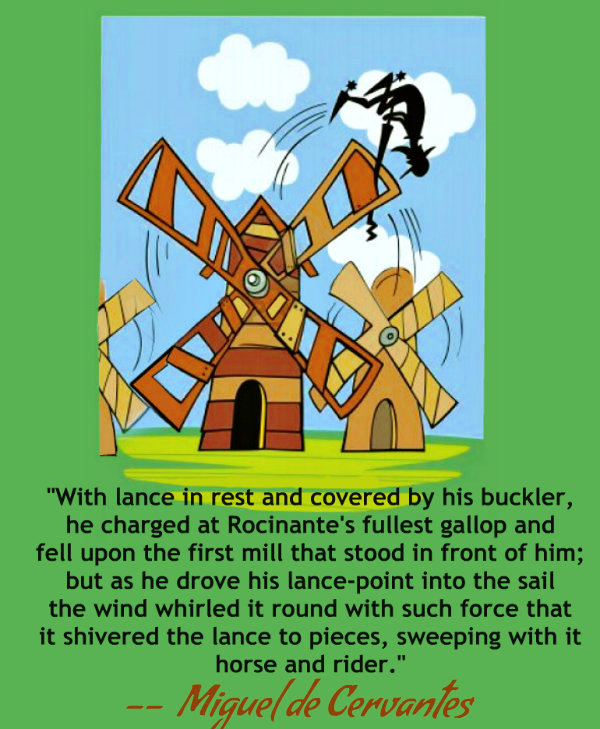

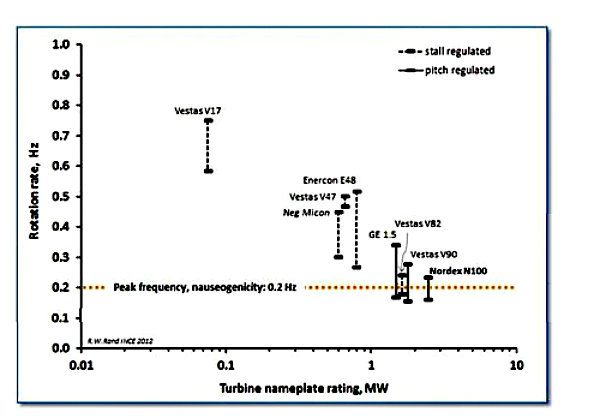
Comment by David Moriarty on 01/03/2013 at 8:23 pm
Could this be the begining of the end of denial of wind turbine LFN and infrasound? Let us all hope and pray. Can President Obama and the governors of this great nation of ours continue with this sham on the American public? Or have the winds of reason and change finally caught up with them?
Comment by Fiona on 01/03/2013 at 9:41 pm
I can only pray it is the beginning of the end of these horrific industrial wind turbines.
Comment by mtumba on 01/03/2013 at 10:42 pm
This sounds like the proverbial crack in the dike, inshallah.
Comment by Young on 01/04/2013 at 12:20 am
Yes, let’s hope this is the beginning of an end to all the lies.
Comment by Marco Bernardi on 01/04/2013 at 12:24 pm
I am sure Mr. Leventhall knows this guy: “No one has the intention of building a wall” (GDR government and party leader Walter Ulbricht on 15 June 1961 during a press conference in East Berlin).